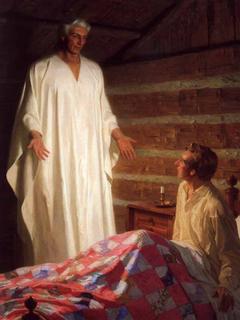The Anagogical Reading of Sacred Text: Then and Now, As Was Prophesized
“And other sheep I have, which are not of this fold: them I also bring, and they shall be one fold, and one shepard.” -John 10:16, the King James Bible.  “He [the Angel Moroni] said there was a book deposited, written upon gold plates, giving an account of the former inhabitants of this continent, and the source from which they sprang. He also said that the fullness of the everlasting Gospel was contained in it, as delivered by the Savior to the ancient inhabitants.” -Joseph Smith describing the visit of an angel, leading to his “unearthing” of what will become the Book of Mormon, 1830.
“He [the Angel Moroni] said there was a book deposited, written upon gold plates, giving an account of the former inhabitants of this continent, and the source from which they sprang. He also said that the fullness of the everlasting Gospel was contained in it, as delivered by the Savior to the ancient inhabitants.” -Joseph Smith describing the visit of an angel, leading to his “unearthing” of what will become the Book of Mormon, 1830.
Among the four manners for interpreting the Bible, I found the anagogical method of interpretation to be of significant interest. Auerbach touches upon this when he discusses the role of the Bible for converting Celtic and Germanic peoples during the medieval age, in which the Old Testament was rejected as history of the Jewish people and instead taught as a precursor to the New Testament. Auerbach writes “the figural interpretation changed the Old Testament from a book of laws and history of the people of Israel into a series of figures of Christ and the Redemption, such as we find later in the procession of prophets in medieval theater…” (52). In this sense, the emphasis of the reader is on the anagogical, with the Old Testament standing as prophesy for the coming of Jesus. This is a fascinating concept given the anti-Semitism prevalent in Europe at the time. (How does one degrade a people whose very foundation of religion is existent in one’s own? Reject their history and focus on the spiritual teachings.) This alternative explanation for the Old Testament works when one assumes that God is outside of time and knows all that will happen, with God’s word in the Bible acting as prophesy for that which will, and has, come to pass. This method of reading the Bible becomes important for religions that incorporate preceding religions’ sacred texts. For example, the Church of Jesus Christ of Latter-Day Saints (LDS, or Mormons) famously refer to the Book of Mormon, which describes events in the Americas during Biblical times, as “Another Testament of Jesus Christ,” but also regard the Bible as being the word of God (The Doctrine of Covenants and the Pearl of Great Price round out the holy scriptures of this religion). It has often been quoted by LDS members (as Mormons refer to themselves) that the Bible directly refers to the Book of Mormon in John 10:16 (above) in which Jesus speaks of “other sheep.” In this sense, the Church of Latter-Day Saints reads this verse in an anagogical manner, somewhat in the method in which the newly converted Celts and Germans were expected to read the Old Testament in the medieval ages. The reading of the Old Testament as a series of Prophets and Redeemers also becomes interesting in the anagogical sense when applied to the history of the Latter-Day Saints, in which Joseph Smith—regarded by the Church as the Lord’s Prophet—restores the “true church” on Earth. Smith’s murder at the hands of an angry mob turn him into a martyr, and this leads to the dispelling of his people from their home in Missouri, forcing them to wander the desert until they find a permanent home in what is now Salt Lake City. Smith’s death as martyr, and the wanderings of his people—which the Church refers to as an exodus—clearly echo events in both the Old and New Testaments, creating a biblically prophetic birth of a distinctly American religion.
 “He [the Angel Moroni] said there was a book deposited, written upon gold plates, giving an account of the former inhabitants of this continent, and the source from which they sprang. He also said that the fullness of the everlasting Gospel was contained in it, as delivered by the Savior to the ancient inhabitants.” -Joseph Smith describing the visit of an angel, leading to his “unearthing” of what will become the Book of Mormon, 1830.
“He [the Angel Moroni] said there was a book deposited, written upon gold plates, giving an account of the former inhabitants of this continent, and the source from which they sprang. He also said that the fullness of the everlasting Gospel was contained in it, as delivered by the Savior to the ancient inhabitants.” -Joseph Smith describing the visit of an angel, leading to his “unearthing” of what will become the Book of Mormon, 1830.Among the four manners for interpreting the Bible, I found the anagogical method of interpretation to be of significant interest. Auerbach touches upon this when he discusses the role of the Bible for converting Celtic and Germanic peoples during the medieval age, in which the Old Testament was rejected as history of the Jewish people and instead taught as a precursor to the New Testament. Auerbach writes “the figural interpretation changed the Old Testament from a book of laws and history of the people of Israel into a series of figures of Christ and the Redemption, such as we find later in the procession of prophets in medieval theater…” (52). In this sense, the emphasis of the reader is on the anagogical, with the Old Testament standing as prophesy for the coming of Jesus. This is a fascinating concept given the anti-Semitism prevalent in Europe at the time. (How does one degrade a people whose very foundation of religion is existent in one’s own? Reject their history and focus on the spiritual teachings.) This alternative explanation for the Old Testament works when one assumes that God is outside of time and knows all that will happen, with God’s word in the Bible acting as prophesy for that which will, and has, come to pass. This method of reading the Bible becomes important for religions that incorporate preceding religions’ sacred texts. For example, the Church of Jesus Christ of Latter-Day Saints (LDS, or Mormons) famously refer to the Book of Mormon, which describes events in the Americas during Biblical times, as “Another Testament of Jesus Christ,” but also regard the Bible as being the word of God (The Doctrine of Covenants and the Pearl of Great Price round out the holy scriptures of this religion). It has often been quoted by LDS members (as Mormons refer to themselves) that the Bible directly refers to the Book of Mormon in John 10:16 (above) in which Jesus speaks of “other sheep.” In this sense, the Church of Latter-Day Saints reads this verse in an anagogical manner, somewhat in the method in which the newly converted Celts and Germans were expected to read the Old Testament in the medieval ages. The reading of the Old Testament as a series of Prophets and Redeemers also becomes interesting in the anagogical sense when applied to the history of the Latter-Day Saints, in which Joseph Smith—regarded by the Church as the Lord’s Prophet—restores the “true church” on Earth. Smith’s murder at the hands of an angry mob turn him into a martyr, and this leads to the dispelling of his people from their home in Missouri, forcing them to wander the desert until they find a permanent home in what is now Salt Lake City. Smith’s death as martyr, and the wanderings of his people—which the Church refers to as an exodus—clearly echo events in both the Old and New Testaments, creating a biblically prophetic birth of a distinctly American religion.


0 Comments:
Post a Comment
<< Home